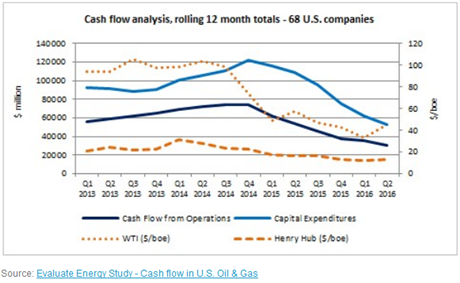Dramatic shifts have taken place in the way U.S. oil and gas operators view cash flow, capital expenditure (cap-ex) and market risk – with companies closer today to being able to fund cap-ex plans with only their operating cash flow than at any point since the price downturn began.
U.S. oil and gas companies spent 57% less in cap-ex in Q2 2016 compared to the end of 2014 on a rolling 12 month basis – and this is finally having a material impact on production. That is one of the key findings of a far-reaching study of cash flow trends for 68 U.S. oil and gas companies by Evaluate Energy.
The study examines the size of the financing gap that exists between a company’s operating cash flow and its cap-ex spending. This gap varies very significantly, depending on the size of company and location of its production, and this large cut in cap-ex is undoubtedly a key driver of falling financing gaps in more recent periods.
Click here to read the full report.

The size of the internal financing gap is crucial, not least because it determines how far each company is able to fund cap-ex via after-tax profits and conversely its level of reliance upon external cash to fund development plans. It also provides a gauge of company confidence – and, crucially, it points to how far benchmark prices would need to rise to ensure a company could entirely fund cap-ex using just operating cash flow.
The sharp cut off in cap-ex over the past two years is finally starting to bite on production. Cap-ex has been cut across the board since the end of 2014. While production trended upward from 2013 for a few quarters into 2015, we are now starting to see the rate of growth decline. While Q2 2016 production is around 40% higher than Q1 2013, it is similar to Q1 2016.

“This production plateau does not bode well for near-term cash flow growth, assuming there is no sudden and significant recovery in commodity prices,” said Mark Young, senior analyst at Evaluate Energy. “Cash from operations will fall if production begins to drop, and this could lead to further cap-ex cuts.”
The Evaluate Energy study provides analysis on pricing per region based on an analysis of 68 representative U.S. oil and gas companies within its coverage of all U.S. stock exchange-listed operators.
“U.S. oil and gas companies are moving closer to being able to fund cap-ex plans with only operating cash flow than at any point during the past three years,” said Young. “But relatively smaller producers have a much greater reliance on externally sourced cash with greater financing gaps than larger producers.”
Click here to read the full report, which also studies the varying financing gaps between Bakken, Marcellus and Permian Basin producers.